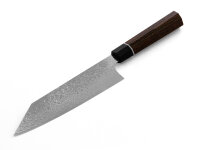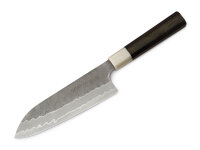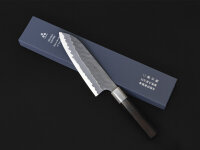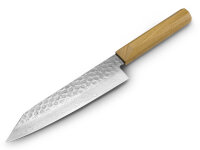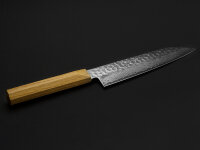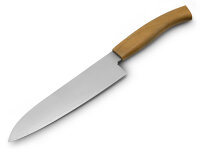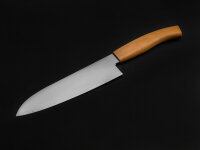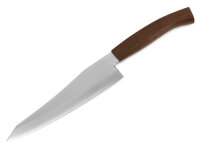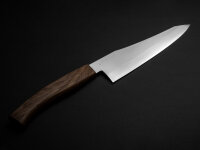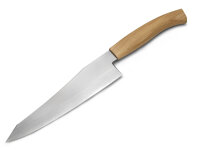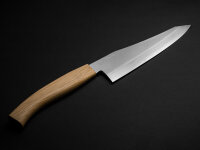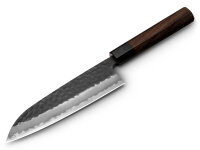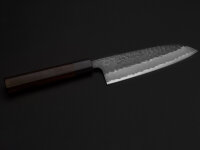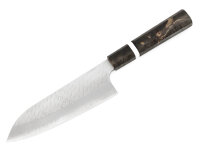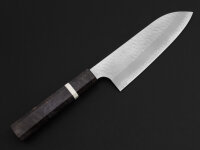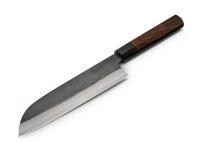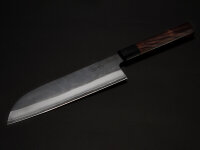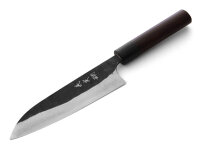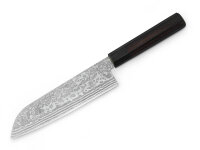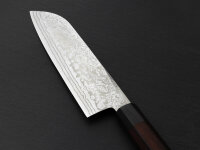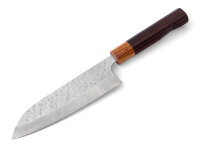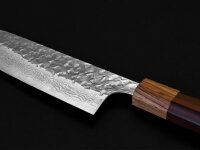
Santoku Knives
Santoku Knives from Japanese Master Smiths
The Santoku knife is called the knife of the three virtues in Japan. The three virtues are fish, meat, and vegetables. This all-purpose knife can, therefore, be used very versatilely. Rapidly slicing fine strips is the specialty of the Santoku. With a blade length between 16 and 18 cm and a wide blade, it is ideal for flexible use.
Cutting with the Santoku Knife
The Santoku knife can be used with both a pulling motion and a pushing motion. There's no need to apply pressure with this chef's knife, as Japanese knives have exceptional sharpness and a slender (thin) blade. The blade is relatively wide, allowing you to guide the knife easily and safely with your fingertip. This reduces the risk of injuries when using Santoku knives.
The noticeable difference from Western-style chef's knives is that Japanese chef's knives have a significantly smaller bevel angle. This kind of edge is achievable only with hard Japanese steel types. The broad blade "glides" through the food, not "splitting" it. The small angle reduces the effort required, which is a crucial factor in addition to sharpness, and it also reduces damage to the food, resulting in a more attractive cut surface. In Japan, particularly in fine cuisine, this aspect is highly valued because we eat with our eyes.
The Santoku knife shape is particularly suitable for cutting fine strips of fish, meat, and vegetables precisely and quickly. With a carefully sharpened Santoku knife, you often only need one stroke, even for several centimeters wide pieces. Fans of Asian stir-fries or wok dishes will quickly appreciate their Santoku chef's knife.
Which Santoku Knife to Buy?
The question of which Santoku knife is the right one is not easy to answer. The basic criteria for buying a high-quality knife apply to purchasing a Santoku knife. However, the question of whether it will be used frequently is already answered by the universal applicability of the Santoku knife. For aspiring chefs and cooks who want to use Original Japanese knives, it is a fundamental tool. Before making a purchase, consider the following questions:
What level of sharpness do you want the chef's knife to have?
This means paying attention to the type of steel used for the cutting core. The outer layer of the knife does not affect sharpness. High sharpness potential is offered by carbon-rich steels like Aogami, Shirogami, and Japanese stainless steel like VG-10 and SUS1A-1.
Am I willing to handle the knife with care?
Knives made of carbon-rich steels are not stainless. The Aogami Santoku does not require much maintenance, as often noted, but it should never be put in the dishwasher, left in water, or stored in a damp place. In such cases, a Damascus knife with a stainless cutting core might be the right choice; the commonly used VG-10 is stainless and still harder than the stainless steels typically used in the West. When making an informed choice, consider that even a Western stainless steel knife should not go in the dishwasher. It won't be destroyed, but its sharpness will suffer significantly, especially since these knives generally have less hardness and edge retention.
How much do I value a knife with good craftsmanship?
This criterion should be thoroughly examined, as far as possible. Indications of good craftsmanship certainly include the tradition and reputation of the blacksmith (similar to a reputable brand). Hand-forged Japanese kitchen knives in the lowest price range should be critically questioned. Japan is not a low-wage country, and hand-forged Japanese knives are not mass-produced. How can a high-quality knife be produced inexpensively by hand?
Am I willing to pay more for a knife with a more appealing appearance?
The appearance of a Japanese knife can also play a significant role. Kitchen knives made of Damascus steel, which are produced with great effort and are popular among many buyers, are clear evidence of this. But also knives with a rustic Kuroshiage finish or knives with a beautiful Pear Skin surface are becoming increasingly popular. Moreover, these also offer some functional advantages.
Body size and hand size
Since a Santoku knife is versatile and will be used frequently, it's essential to consider how well the kitchen knife fits you. Santoku-shaped kitchen knives usually have blades that are 15 cm to 20 cm long. Aogami Santoku knives are heavier than Santoku Damascus or the Santoku Knife Yuri made of SUS1-A-1 stainless steel. Therefore, your choice of blade length depends on what you intend to cut. 15 cm is relatively small for a Santoku knife. We offer Santoku chef's knives with blade lengths of 16.5 cm, 17 cm, 18.5 cm, and 19 cm, with the Santoku knife Yuri, which has a blade length of 19 cm, being very lightweight and easy to handle, especially for female cooks.
The best Santoku knife
is undoubtedly the Santoku knife that possesses high craftsmanship, steel with high sharpness potential, an appealing appearance, good balance, and the right length. When a careful owner who handles the universal knife skillfully is added to the equation, the Santoku knife is perfect.
Which Grind to Prefer? And What Are Kullens?
Is a Santoku knife with kullens better than a Santoku with a smooth blade? In general, the smoother the blade, the more likely it is to retain food. The indentations worked into the blade with kullens are intended to prevent or reduce this sticking. We have found that even with Santoku knives like Kuroshiage, Damascus, or knives with Pear Skin Finish, the food sticking is noticeably less than with smooth stainless steel blades. Since kullens might weaken the knife blade rather than strengthen it, the potential disadvantage may outweigh any presumed advantage. We have observed noticeable non-stick effects with the following kitchen knives:
- Santoku Knife Damascus, Kuroshiage Nami »
- Santoku Knife Yoshimi Kato Damascus SG2 Olive »
- Santoku Knife 165mm, Yoshimi Kato Nashiji (Pear Skin Finish) »
- Damascus Santoku Knife 165mm, Yoshimi Kato Kurosome (burnished finish) »
How to Sharpen a Hand-Forged Santoku Knife?
Hand-forged Japanese kitchen knives should be sharpened exclusively with water sharpening stones. This applies, of course, to the Santoku knife as well. A honing rod can damage the kitchen knives or result in the need for extensive resharpening. This is because the cutting core and therefore the cutting edge often consist of carbon steel, and honing with a rod can potentially break off pieces of the steel. So, sharpening stones are the way to go. Our Japanese partners recommend using artificial stones because they are more evenly made and have a more homogeneous grit.
What grit should be preferred for the knife? If you plan to regularly sharpen your Santoku knife, a fine grit above 800 or 1000 should suffice. Coarser grits are only necessary if a preliminary sharpening is required because the knife is very dull or has damage. Whether very fine grits make sense depends on the knife's sharpening potential, which depends on the type of steel. Patient enthusiasts sometimes work with 3000 or even higher grits to achieve the ultimate sharpness.
Which Handle to Choose for Your Japanese Knife?
Traditional Japanese kitchen knives offer three handle shapes: round, oval, octagonal. Knives with other handle shapes are Western-inspired and are likely manufactured primarily for export reasons.
If you are considering the handle shape for your kitchen knife, it is wise to include the handle's characteristics and thus the requirements for the handle in your considerations. In general, Santoku and other Japanese kitchen knives require much less effort than Western-style kitchen knives. This is due to their sharpness, thinner blade, and lower weight.
Whether you prefer a round, oval, or octagonal handle for your Santoku knife is also a matter of personal preference. The octagonal shape, as offered with our Santoku knife Yoshimi Kato Nashiji, provides a bit more grip. However, the edges might be slightly uncomfortable for extended use and sensitive hands. According to our partners in Japan, who deal with this issue daily, Japanese chefs prefer round handles.
Overview of Our Original Santoku Offer:
Damascus Santoku Knife 165, Kuroshiage Nami
Layers: 12 | Blade: 16.8 cm | Total: 31.3 cm
Santoku Knife Yamato
Layers: 3 | Blade: 18.5 cm | Total: 31 cm
Santoku Knife Yuri
Layers: 3 | Blade: 19 cm | Total: 31 cm
Santoku Knife Yoshimi Kato SG2 Olive
Layers: 63 | Blade: 17 cm | Total: 31 cm
Santoku Knife 165, Yoshimi Kato Nashiji
Layers: 3 | Blade: 16.5 cm | Total: 31 cm
Damascus Knife Santoku 165, Yoshimi Kato Kurosome
Layers: 30 | Blade: 16.5 cm | Total: 31 cm
Damascus Knife Santoku 165, White Ebony, 35 Layers
Layers: 35 | Blade: 16.5 cm | Total: 31 cm
Damascus Knife Zuiun Santoku 180, 62 Layers
Layers: 62 | Blade: 18 cm | Total: 33 cm
Damascus Knife Saiun Santoku 170, 32 Layers
Layers: 32 | Blade: 17 cm | Total: 30 cm
Damascus Knife Santoku 165 Rose Ebony, 35 Layers
Layers: 35 | Blade: 16.5 cm | Total: 31.2 cm
Kotetsu Santoku 180 All-Purpose Knife
Layers: 1 | Blade: 18 cm | Total: 31.2 cm
Care Tips:
On our YouTube channel, you can find a video tutorial on how Japanese masters sharpen knives on a Japanese whetstone.

